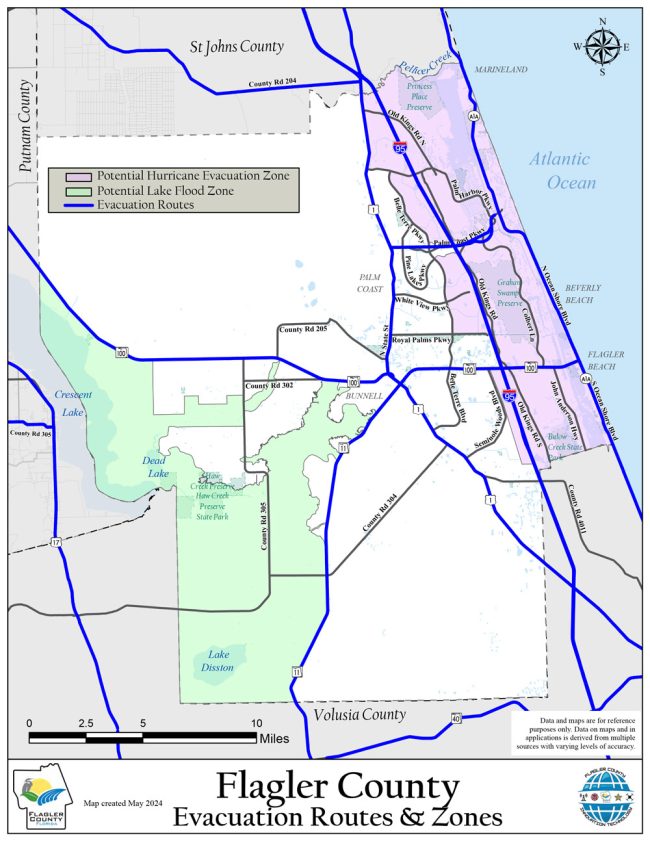
While Flagler County Emergency Management Director Jonathan Lord was giving his annual pre-hurricane season briefing to local media near midday today, some pretty significant rattling was taking place above everyone’s head: workers were putting the finishing touches on an $830,000-some roof Lord has been trying to get installed since 2019.
When it was built two decades ago, the Emergency Operations Center in Bunnell was supposed to have the kind of roof that would resist a Category 5 hurricane. But an engineer wouldn’t certify it to that strength when asked in 2019. Plus the roof had sustained damage over the years from recurring storms. That started the discussions for a stronger roof, which can now withstand winds of up to 180 miles an hour.
No such winds have ever been recorded in Flagler County, at least not since the dawn or records, though this is also the era of records-shattering. For an emergency operations center that houses up to 70 of the most essential local personnel and policy-makers from a few dozen agencies during the greatest emergencies, EOC could not afford so much as a chink in its armor. Even the infrastructure housing EOC’s generators is now Cat-5 resistant. Whatever plagued the generators during the Hurricane Milton emergency last year, when they failed, has been fixed and tested.
The roof is no longer green but gray, differentiating it from what had been the signature color of Flagler County government buildings (not least the lock-up often referred to as the Green Roof Inn).
The best part for Lord, as he stood outside the EOC building today, talking about the roof while workers hammered in gutters: it’s 90 percent paid for with federal funds, part of the post-Covid Hazard Mitigation Grant Program administered through the Federal Emergency Management Administration, or FEMA. (The grants were issued during the first federal post-Covid aid program initiated in the first Trump administration.) Better yet: Flagler County’s Emergency Operations Center last year became one of just six of Florida’s 67 counties to be accredited.
“We still have some processes related to maintaining that, we’ve been going through and are passing with flying colors,” Lord told the County Commission last week. “I find that very important to me. It’s not just a sticker and it’s not just something cool to have. It’s an outside entity validating that we’re doing the right thing for our community, versus Jonathan just telling you that we are.”

All of that positions Lord’s EOC as well as it could be positioned to take on the hurricane season bearing down on the Atlantic. It is expected to be another busy one with somewhat more storms, and more violent storms, than the 30-year average. Two organizations issue the most-quoted forecasts every spring: Colorado State University and the National Hurricane Center.
CSU is projecting 17 named storms, three more than the 30-year average, and nine hurricanes, two more than the average. Four of those are expected to be major hurricanes, or storms with Category 3 winds or higher (111 miles per hour and up.)
The National Hurricane Center projects ranges rather than precise numbers: 13 to 19 named storms, six to 10 hurricanes, three to five of them major. There were 18 named storms in 2024.
This year’s storms will begin with Andrea, Barry and Chantal (that’ll bring back unhappy memories for Texans and the Gulf of Mexico in 1989, where that year’s Chantal left 13 dead, 10 of them on an oil rig). Many of this year’s names, as in previous years, are recognizable retreads from previous seasons–Erin, Fernands, Gabrielle and so on. Donald is not on the list.
“But as I tell you guys every year, the forecast is not the most important thing,” Lord said, “because if we have the quietest year ever, one storm hitting our community is bad.” The season is between June 1 and Nov. 1, though the dates are not fail-safe. Flagler County’s and Florida’s peak season is September and October.
No organization projects dates or trajectories. That’ll be left to the various models, NHC’s included, once a storm begins to form either off the coast of Africa or in the Caribbean. But the National Hurricane Center’s “cone of probability” has been made yet more precise this year, if just slightly, meaning that it will look narrower once the public gets its first look.
“The weather services in the past used to only just [show] the cone and then maybe colored hurricane or tropical storm right along the coastline,” Lord said. “Now they’re carrying that further inland to make it better messaging.”
Lord says dust storms clouding West Africa right now are helping to tamp down hurricane activity. On the other hand, ocean water temperatures drive hurricane forecasts. The higher the temperature, the more frequent the hurricanes. The water temperature is higher than average.
As for evacuation zones, those changed last year, going from what used to be A-B-C-D-E-F zones to more precisely named hurricane evacuation zones to Palm Coast residents would not confuse the alphabetical references with their neighborhoods, most of which are still identified by their alphabetical letter. The new science of forecasting also made it possible to target evacuations by neighborhood. “That was not feasible five years ago, it became feasible three years ago, and we obviously locked it in last year,” Lord said.
The bridges will not close during tropical storm or hurricane emergencies. But all evacuations will be mandatory. “There’s no such thing as a voluntary evacuation,” Lord said. At the same time, no evacuation is enforceable: cops or anyone else will not force anyone to leave their home. But emergency services will not go to those homes during severe weather emergencies.
The Flagler Humane Society continues its role as a shelter for animals during emergencies. “I don’t know what we do without them,” Lord said of the often-maligned society. “We don’t have county staff that could do that, and they are volunteers as well as their staff. And they bend over backwards to make sure that we can also evacuate people with their normal domestic pets. Not strange, exotic animals.”

Flagler County continues to partner with Flagler schools for shelters during severe storms, but the county, through an initiative championed by Commissioner Leann Pennington, became one of just three counties to get a $10 million state appropriation enabling the construction of a non-school-based emergency shelter. That 10,000 square foot shelter, with 5,000 square feet of storage, bathrooms and kitchen, will be built by Cattleman’s Hall at the county fairgrounds.
The building will be just as wind-resistant as the Emergency Operations Center, and it is slated for completion by next summer. It’ll accommodate some 500 cots. The hope, as always, is that neither building nor cots are ever needed.
Failing that, there’s always the inspirational advice Lord offers his staff, usually by way of a saying by a historic figure. This month’s, penned on a whiteboard at the entrance to the large emergency operations room, is by Francis of Assisi, who was known to have pulled off an impossible thing or two in his saintly life eight centuries ago: “Start by doing what’s necessary, then do what’s possible, and then suddenly you are doing the impossible.”
![]()




























SIRWASTEALOT says
Are you kidding me ? The amount of money Flagler County and the City of Palm Coast wastes is astronomical. This is absurd. A properly built building and a generator is all this area has ever needed. Is this some kind of contest to find the dumbest things to waste money on ? Sure seems that way
Duane says
Who taught these people how to use ladders?
Ray says
looks like a very well-constructed facility. No windows exposed, front looks protected with the steel doors. I highly doubt any wind could get inside to blow the roof off. I wish my house was built that beefy.
Carol Bacha says
Why then are the current Flagler County and Palm Coast apartments and homes only getting roofs with wind speed resistant to 125 and 135 miles per hour, when they are built and coded as new. This has an impact on our home insurance costs. Why not build better quality roofing on new homes in Flagler County, so we have a decent shelter in place in time of storms and not a cot with 500 others?
Steve says
I hate to break it to you all but there is no such thing as CAT5 Proof or resistant. When it comes that building and all the rest will go. IMO
Throw my hands up, again in Flagler says
Leave it to Flagler County once again. The county is crying poverty on beach renourishment attempting to slip another “VEILED TAX” on its residents. In a desperate scramble to replace the sand for the private vacation homes on the beach fortunately in was stopped cold by Commissioner Carney. Commissioner Carney has countlessly pointed out waste and mismanagement in Flagler County and once again the county never ceases to amaze. $ 850, 000 dollars for a roof that boasts it is Cat 5 proof. Just like the Titanic was unsinkable.
Has anyone noticed the almost million dollar roof in the photo was being installed by workers who don’t seem to know how to properly use a latter ?
Another Flagler County home run.
Joe D says
For Carol Bacha:
The County COULD insist on category 5 wind resistance for new residential construction, but I don’t think you would be happy with the COST! It could increase the COST of your home’s building by as much as 50%.
When I bought my retirement home (moving from another hurricane prone coastal state) across from the beach in Flagler Beach, I insisted on an ELEVATED (8ft) townhouse, with poured concrete and cabled (not just rebar) reinforcing to allow flexing in the wind. It also has 2 concrete slab floors and a concrete slab roof. It has hurricane shutters over the glass walls.
The development was built in 1979, and has survived with only minimal storm damage, despite MAJOR storms in the area since they were built ( I actually get MAJOR insurance discounts due to its construction). However, it was not cheap, but I told my agent I wasn’t buying a cheaper ground level home that was going to be routinely flooded or wind damaged.
So, you CAN insist on a home more strongly storm resistant…but you have to then be willing to pay the price.
Ray W, says
From my childhood years, the News-Journal used to publish an article every year on Tax Freedom Day, which was and still is defined as the date the average American stops working for the government and starts earning money for herself. An independent foundation, unsupported by tax dollars, studies the data and releases the date each year.
The idea is simple. Determine the amount of gross annual payroll for all American workers for a year. Then, use that figure to determine the percentage the combined municipal, county, state and federal tax burden will be for the year. Once one has the percentage, a date can be determined.
In 1970, Tax Freedom Day was April 19th.
In 1980, Tax Freedom Day was April 21st.
In 1990, Tax Freedom Day was April 21st.
In 2000, Tax Freedom Day was May 1st.
In 2010, Tax Freedom Day was April 9th.
In 2020, Tax Freedom Day was April 15th.
In 2025, Tax Freedom Day was April 23rd.
Under the allegedly progressively rising tax paradigm from the earliest days of taxing wages earned by ordinary Americans, whenever workers earned relatively more money, they paid a higher percentage and a greater sum in total taxes. Therefore, Tax Freedom Day falls later in the year during good economic times. In 2000, when the economy was comparatively strong for the average American, May 1 was the date of transition. In bad times, Tax Freedom Day falls earlier in the year. In 2010, when America was still in the grip of the Great Recession, Tax Freedom Day fell more than three weeks earlier than it did in 2000.
Even 2020, with all of the federal stimulus money pumped into the economy starting in March of that year, saw a relatively early tax freedom date.
If one looks at individual years for tax freedom dates, over the last 55 years, the vast majority of the dates fall on or around April 20th.
If all of this withstands scrutiny, this year’s relatively late Tax Freedom Day supports my long-standing argument, bolstered by positions taken by the Economist and the Wall Street Journal, that the Biden administration handed over to the Trump administration an economy that was the “envy of the world.”
Tax freedom dates for regions may greatly differ from the national date, as well as from other regions, due to unique local economic conditions. West Virginia’s tax freedom date may be far different from Arizona’s each year.
Can it legitimately be argued that for the average working American, the percentage of the tax burden compared to total wages has remained roughly the same for the past 55 years, varying only by economic hiccups that occur for a multitude of reasons?
Individual perceptions may vary, but then again, they always do, whenever taxes are concerned. Taxes are always going up, many say, but perhaps they are not looking at whether total payroll is rising, too, when they make this claim.
If the commenting standard is whether someone likes something (if I like something, it is right, and if I don’t like something, it is wrong), then to many we are buried in taxation. If the commenting standard is whether the facts support a position, regardless of what we like, then we may not be buried in taxation after all.
One the other hand, no one can dispute that we are buried in an ever-rising level of federal debt due to irresponsible actions taken by both of our political parties over the past 45 years. No nation with two political parties that share taxing power can go from a tax debt of less than $1 trillion to a debt of over $36 trillion over 45 years without each party engaging in irresponsible actions.
Jason says
I hope we don’t have 20 or more named storms since they are only prepared for 19. The roof might collapse then for sure.
danm says
Blowin some HEEP BIG SMOKE. Good luck with that CAT5 guarantee from WHO?
Joe D says
Follow up for Carol Bacha:
SEACH the internet for “BABCOCK RANCH, Florida”. It has homes/buildings built to withstand 150 mph winds, all the utility lines are buried underground, they have self contained water supply system and solar power (neither of which went down during Hurricane Ian, which flattened nearby towns).
Unfortunately the price ranges are $300k to $4 million…everything comes at a PRICE!